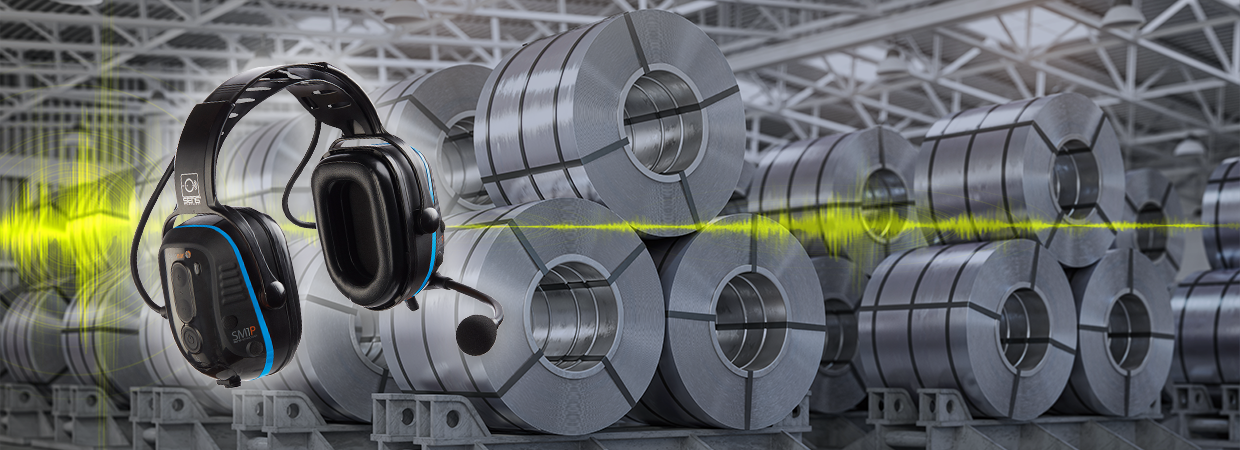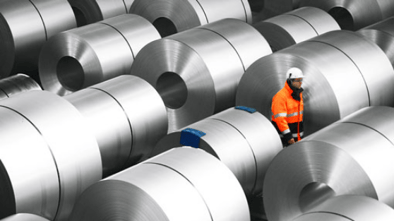- Home
- Blog
- Hearing Protection
- Improving Safety and Productivity in the Steel Industry

Improving Safety and Productivity in the Steel Industry

The steel industry is one of the largest global industries in the world, employing over 6 million people worldwide. It is also one of the louder industrial sectors, with the average noise exposure ranging between 85-92 dB(A) from various equipment including compressors, machine grinders, jets, and hammers. The noise generated by hot and cold rolling mills alone can reach up to 100 dB(A).
Prolonged exposure to this noise can lead to noise-induced hearing loss (NIHL), one of the most serious occupational risks and the most common type of occupational hearing loss. In fact, several studies on hearing loss within the steel industry found that hearing loss among steelworkers increases by 1.5 dB every year, with about 33.5% of steelworkers having NIHL.
The major potential risk for steelworkers is hearing damage or deafness from overexposure to industrial noise. However, beyond the problem of high-noise exposure, steelworkers also face issues with personal safety from large equipment and miscommunication during emergency situations. What kind of solution exists to solve these factors?
Addressing Total Safety when Looking for Hearing Protection
When working in high-noise environments, there are many contributing factors to the safety level of workers. Suppressing hazardous noise is only the first step and can potentially create other concerns if workers aren’t effectively able to communicate or react to potential risks around them. So, what features should you look for when considering the ideal and safest hearing protection for your high-noise work environment?
The following four features should be considered when evaluating hearing protection technologies. Hearing protection is the first feature and probably the most widely achievable by a number of manufacturers and technologies. However, keep in mind that different areas of your work environment may demand different levels of protection. The second feature to evaluate is intrinsic safety and whether the hearing protection solution has been validated by a reputable third-party certification facility. The third feature to look for is situational awareness and ensuring that the solution is capable of isolating speech and critical environmental safety elements from ongoing hazardous noise. Finally, does the technology meet your communication needs, whether it is Bluetooth® wireless technology, FM short-range, two-way radio, or face-to-face?
1. Hearing Protection
In the steel industry, there can be several different hazardous noise levels depending on the location and type of work. When it comes to noise, there are three main types of noise frequencies that play critical roles in industrial work environments: broadband noise, impulse noise, and tonal noise.
Broadband noise (also called wideband noise) is "noise whose sound energy is distributed over a wide section of the audible range" (Acoustic Glossary: Sound and Vibration Terms and Definitions). Broadband noise can be anything from speech frequencies to loud machinery frequencies, where the noise has random or broad patterns.
Impulse noise is noise characterized by sharp, brief increases in dB volume. High-decibel impulse noises can cause temporary or permanent hearing loss, as they are constant and deafening. In steel mills, drop-forge hammers are an example of impulse noise.
Tonal noise (otherwise known as discrete frequency noise) is flat noise that occurs at a single frequency. Tonal noises include blades, fans, motors, or other moving parts that rotate or vibrate.
Depending on the noise level of your specific work area, double (or dual) hearing protection may also be needed. Traditional dual protection is typically used for environments over 95 dB(A) and involves the combined use of earplugs and earmuffs. The problem with traditional dual protection is that you lose communication and situational awareness. Look for products that provide dual protection while also allowing other critical elements discussed here for optimum employee safety.
2. Intrinsic Safety
Intrinsic safety is an approach to safely designing products for hazardous areas with the idea of reducing the available energy to a level too low to cause an ignition. Intrinsically safe equipment is certified and rated by directives like ATEX, IECEx, and more, depending on which country you are operating in. Asking for a manufacturer’s certification and validating the product was certified by a reputable and recognized third-party institution is critical if working in an environment that requires this level of protection.
3. Situational Awareness and Personal Safety
Situational awareness is the perception of an individual’s environmental elements and events with respect to time or space. In simple terms, it is the ability to be aware of peripheral elements in your environment. Can you hear a safety alarm? Are you aware that a vehicle or forklift is approaching from behind you? Hearing devices that provide the optimum level of noise suppression should also provide employees the ability to have a safe and cognitive awareness of their surroundings. Systems that offer a variety of means to communicate should also deliver the capability to prioritize communications so that critical safety announcements take priority over other connections and communications.
4. Clear and Effective Communication
In high-noise environments, communicating while remaining compliant with much-needed hearing protection at all times can be a challenge. However, communication in these dangerous environments can be just as critical as hearing protection. Your hearing protection solution should provide fundamental safety needs while also offering flexibility to your individual ancillary communication devices. Most environments rely on face-to-face, two-way radio, Bluetooth®, or short-range for their means of effective communication. The headset that you use should have the capability to meet all your communication needs.
With all these different means of communication, it is crucial that your solution prioritize specific channels of communication that are based on your level of safety. Can Bluetooth® be interrupted if a safety announcement is broadcast over your two-way radio? These are aspects that are often overlooked during the solution definition phase and not realized until devices are fully operational.
How Sensear Meets the High-Noise Needs of the Steel Industry
Sensear is a global leader in developing and manufacturing a wide variety of best-in-class Digital Communication Headsets and Earplugs for use in high-noise environments. Our products meet ATEX, IECEx, and other regionally specific requirements for operating in intrinsically safe environments. We also offer the only ATEX and IECEx-certified double hearing protection devices for extreme noise environments.
With our unique SENS® Technology, steelworkers can have seamless face-to-face conversations with other workers in the area without needing to yell or remove their hearing protection and can communicate clearly on their two-way radios or Bluetooth® wireless technology enabled devices, all while protecting their hearing and maintaining 360° situational awareness.
We also recognize that comfort and fit come into play with gaining employee compliance and satisfaction. We make our headsets available in three different styles that can address user preference and the several clothing restrictions in steel mills, such as hats, helmets, or gloves. Sensear also provides extreme noise earplugs with our proprietary SENS® Technology for use with respirators or other facial restrictors.
Sensear is the perfect solution for workers in the steel industry. Contact us today for a comprehensive needs evaluation with one of our high-noise specialists.









